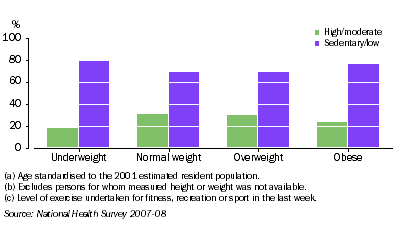Physical Activity
One of the main causes of overweight and obesity is an energy imbalance between calories consumed and calories expended over time(footnote 1) . Physical activity, such as exercise, increases the body’s normal energy expenditure. However, the total amount of energy exhausted depends on the type of physical activity and the individual performing it(footnote 2) . For adults, the National Physical Activity Guidelines recommend at least 30 minutes of moderate-intensity physical activity on most, preferably all, days of the week(footnote 3) .
In the 2007-08 NHS, adults were asked questions about all exercise undertaken for fitness, recreation or sport in the week prior to the survey. They were then grouped into exercise levels (sedentary, low, moderate or high) based on a score derived from the frequency, duration and intensity of their physical activity in the previous week.
After adjusting for age, obese adults were less likely than normal weight and overweight adults to:
- exercise at high or moderate levels for fitness, recreation or sport;
- exercise 3 or more days; and
- meet the recommended guidelines for exercise.
5.1 Measured Body Mass Index(a)(b), by Level of exercise(c)

Obese adults were also more likely than normal weight and overweight adults to:
- be sedentary or exercise at low levels for fitness, recreation or sport;
- exercise 2 or less days; and
- do no exercise.
While physical activity in the last week may be a good indication of the amount of energy expended by individuals, it should be interpreted with caution as the effects of physical activity on body weight happen over time. Hence, any recent changes to a person’s exercise routine may not be reflected in their body weight. In addition, overall physical activity such as that undertaken for work needs to be taken into consideration.
1 WHO (World Health Organisation) 2006. World Health Organisation Fact Sheet 311
<back
2 WHO (World Health Organisation) 2000. Obesity: preventing and managing the global epidemic. Report of a WHO consultation. Technical report series 894. Geneva: WHO
<back
3 Department of Health and Ageing 2005. National Physical Activity Guidelines for Adults. Available from http://www.health.gov.au/internet/main/publishing.nsf/content/phd-physical-activity-adults-pdf-cnt.htm <back
 Print Page
Print Page
 Print All
Print All